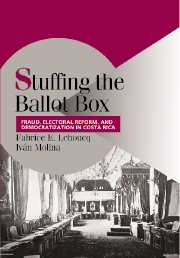Book contents
- Frontmatter
- Contents
- List of Tables and Figures
- Preface
- INTRODUCTION
- 1 ELECTORAL FRAUD DURING INDIRECT AND PUBLIC ELECTIONS, 1901–12
- 2 INSTITUTIONAL CHANGE, ELECTORAL CYCLES, AND PARTISANSHIP, 1910–4
- 3 ELECTORAL FRAUD DURING THE PUBLIC BALLOT,1913–23
- 4 INSTITUTIONAL CHANGE, ELECTORAL CYCLES, AND PARTISANSHIP, 1924–8
- 5 ELECTORAL FRAUD DURING THE SECRET BALLOT, 1925–48
- 6 POLITICAL POLARIZATION, ELECTORAL REFORM, AND CIVIL WAR, 1946–9
- CONCLUSION: BALLOT-RIGGING AND ELECTORAL REFORM IN COMPARATIVE PERSPECTIVE
- Index
- Cambridge Cultural Social Studies
5 - ELECTORAL FRAUD DURING THE SECRET BALLOT, 1925–48
Published online by Cambridge University Press: 16 July 2009
- Frontmatter
- Contents
- List of Tables and Figures
- Preface
- INTRODUCTION
- 1 ELECTORAL FRAUD DURING INDIRECT AND PUBLIC ELECTIONS, 1901–12
- 2 INSTITUTIONAL CHANGE, ELECTORAL CYCLES, AND PARTISANSHIP, 1910–4
- 3 ELECTORAL FRAUD DURING THE PUBLIC BALLOT,1913–23
- 4 INSTITUTIONAL CHANGE, ELECTORAL CYCLES, AND PARTISANSHIP, 1924–8
- 5 ELECTORAL FRAUD DURING THE SECRET BALLOT, 1925–48
- 6 POLITICAL POLARIZATION, ELECTORAL REFORM, AND CIVIL WAR, 1946–9
- CONCLUSION: BALLOT-RIGGING AND ELECTORAL REFORM IN COMPARATIVE PERSPECTIVE
- Index
- Cambridge Cultural Social Studies
Summary
Introduction
Despite the resistance of Congress, the secret franchise had become the law of the land. Reform had also stripped parties of the ability to furnish voters with paper ballots on election day. The new law required parties to submit the names of their candidates to the secretary of the interior a month before election day. The secretariat of the interior then printed ballots containing the names, colors, and portraits of presidential candidates. The parties' ability to distort the will of an electorate that, by the late 1920s, consisted of approximately one hundred thousand voters had abruptly diminished. Public opinion had become a force that parties had to reckon with and one that complicated their political calculations. Or had it?
With one exception, legal denunciations of fraud accompanied every election year; in some years, defeated parties also resorted to the use of violence to gain control of the state. Even after the reforms of the mid-1920s, political folklore suggests that presidents regularly and predictably stuffed the ballot box. In his novel Mamita Yunai, leftist writer and activist Carlos Luis Fallas described how the “official” party handed ID cards to indigenous peoples in the outlying Province of Limón while herding them to a polling station staffed by relatives of the local police chief. Others argue that reformist governments took the fabrication of votes to new heights during the 1940s.
- Type
- Chapter
- Information
- Stuffing the Ballot BoxFraud, Electoral Reform, and Democratization in Costa Rica, pp. 156 - 194Publisher: Cambridge University PressPrint publication year: 2002



